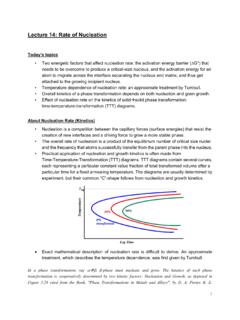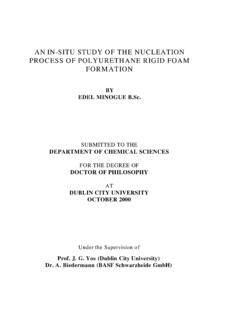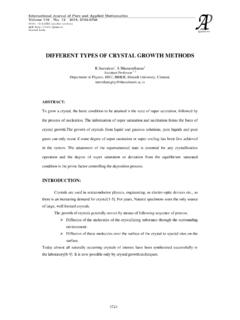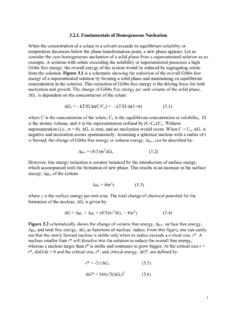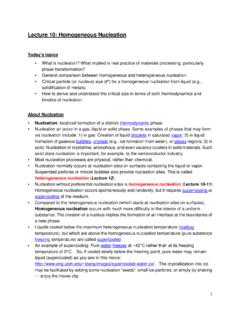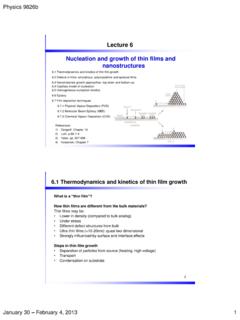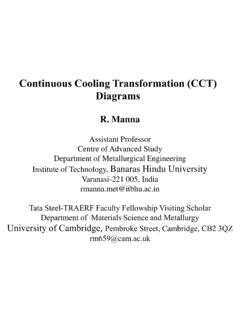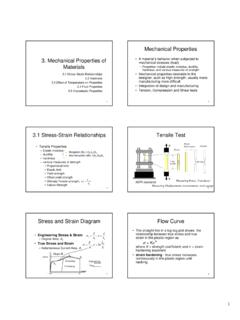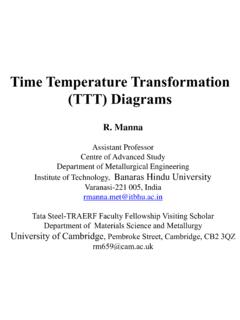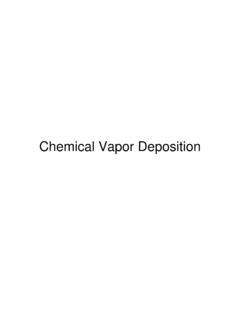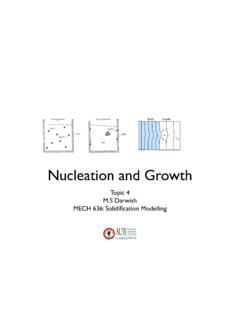Search results with tag "Nucleation"
Lecture 12: Heterogeneous Nucleation: a surface catalyzed ...
my.eng.utah.edunucleation is equal to the product of homogeneous nucleation and a function of the contact angle (q): where f(θ) = • The barrier energy needed for heterogeneous nucleation is reduced (see the plot below). The wetting angle determines the ease of nucleation by reducing the energy needed. 4 2-3cosq+cos3q
Lecture 14: Rate of Nucleation
my.eng.utah.edu• Overall kinetics of a phase transformation depends on both nucleation and grain growth. • Effect of nucleation rate on the kinetics of solidàsolid phase transformation: time-temperature-transformation (TTT) diagrams. About Nucleation Rate (Kinetics) • Nucleation is a competition between the capillary forces (surface energies) that ...
A new technology to manufacture polypropylene …
www.vtt.fi7 Abbreviations ∆G*hom Gibbs free energy for homogenous nucleation ∆G*het Gibbs free energy for heterogenous nucleation γbp surface energy on gas bubble/polymer interface ∆P gas pressure inside a foam cell S(θ) contact angle between a pareticle nucleator and gas ∆Ghom change in Gibbs free energy for homogenous nucleation ∆Ghom change in Gibbs free energy for heterogenous nucleation
Diet Coke and Mentos - Appalachian State University
www.appstate.eduTo overcome this, a nucleation site is generally needed. Gas molecules congregate next to nucleation sites, which break up the network of water molecules. When enough are gathered, they form a bubble. Due to capillary forces, the bubble will initially stay at its nucleation site. But usually, the buoyancy of the bubble will eventually cause
Chapter 3: Igneous Textures - University of Notre Dame
www3.nd.edunucleation and growth as a function of temperature below the melting point. Slow cooling results in only minor undercooling (T a), so that rapid growth and slow nucleation produce fewer coarse-grained crystals. Rapid cooling permits more undercooling (T b), so that slower growth and rapid nucleation produce many fine-grained crystals. Very
NEW DEVELOPMENTS IN BETA NUCLEATION OF …
www.pstc.orgNEW DEVELOPMENTS IN BETA NUCLEATION OF POLYPROPYLENE AND LASER PRINTING OF MICROPOROUS FILMS Philip Jacoby, V.P. of Technology, Mayzo Corporation, Suwanee, GA
AN IN-SITU STUDY OF THE NUCLEATION PROCESS OF …
doras.dcu.iean in-situ study of the nucleation process of polyurethane rigid foam formation by edel minogue b.sc. submitted to the department of chemical sciences
DIFFERENT TYPES OF CRYSTAL GROWTH METHODS
www.acadpubl.euthe process of nucleation. The information of super saturation and nucleation forms the basis of crystal growth.The growth of crystals from liquid and gaseous solutions, pure liquids and pure gases can only occur if some degree of super saturation or …
Process Engineering Laboratory II Crystallization
ethz.chnucleation. A more sophisticated cooling would ensure that the supersaturation remains constant throughout the whole crystallization. This requires knowledge on the growth rate, the nucleation rate, the solubility and the seed crystals, but with some mathematical e …
3.2.1. Fundamentals of Homogeneous Nucleation Figure 3
depts.washington.edunucleation and growth. The change of Gibbs free energy per unit volume of the solid phase, ∆Gv, is dependent on the concentration of the solute: ∆Gv = - kT/Ω ln(C/Co) = - kT/Ω ln(1+σ) (3.1) where C is the concentration of the solute, Co is the equilibrium concentration or solubility, Ω
Lecture 10: Homogeneous Nucleation
my.eng.utah.edutemperature), but which are above the homogeneous nucleation temperature (pure substance freezing temperature) are called supercooled. • An example of supercooling: Pure water freezes at −42°C rather than at its freezing temperature of 0°C. So, if cooled slowly below the freezing point, pure water may remain
Lecture 6 Nucleation and growth of thin films and ...
www.physics.uwo.caPhysics 9826b January 30 – February 4, 2013 1 1 Lecture 6 Nucleation and growth of thin films and nanostructures References: 1) Zangwill, Chapter 16
Continuous Cooling Transformation (CCT) Diagrams
www.phase-trans.msm.cam.ac.uktemperature against cooling rate or bar diameter for each type of cooling medium 2 Definition: Stability of phases during continuous ... The nucleation condition under continuous cooling can be explained by the concept of progressive nucleation theory of Scheil. 17.
Mechanical Properties Materials - Michigan State University
www.egr.msu.edufreezing point the nucleation of crystals has not been initiated. • Implication in casting Temperature Specific volume (density) -1 Glass ... – The quantity of Heat Energy required to increase the temperature of a unit mass of a material by 1 degree. –H=CW(T 2-T 1) where H = amount of heat energy; C = specific heat of the material W = its ...
Time Temperature Transformation (TTT) Diagrams
www.phase-trans.msm.cam.ac.uke1 temperature, coarse pearlite forms at close to A e1 temperature due to low driving force or nucleation rate. At higher under coolings or lower temperature finer pearlite forms. At the nose of TTT diagram very fine pearlite forms Close to the eutectoid temperature, the undercooling is low so that the driving force for the transformation is small.
核生成と界面 - 関西学院大学
ist.ksc.kwansei.ac.jpnucleation) という.この様子を見ておく. ここで重要となるのが表面張力である.図5は下地(substrate:s)の上に固体の核(crystal:c), 溶湯(liquid:l) があるとする.それぞれの界面エネルギーを添え字にして表示している.接触
Chemical Vapor Deposition
users.wfu.eduNucleation, island and step growth. Substrate. Film. Choice of Chemical Reactions • The precursors have to be volatile (gaseous). – Ex: SiH 4 (Silane) is a popular precursor to deposit Silicon. • The chemical reactions need to be thermodynamically predicted to result in a solid
Nucleation and Growth - Missouri S&T - Missouri University ...
web.mst.edu5 Nucleation and Growth • Important for: Phase transitions, precipitation, crystallization of glasses Many other phenomena • Nucleation has thermodynamic barrier • Initially, large compositional change Small in size • Volume transformations α to β phase transformation Avrami equation
Nucleation and Growth - American University of Beirut
www.aub.edu.lbNucleation of Melting While nucleation during solidification requires some undercooling, melting invariably occurs at the equilibrium temperature even at relatively high rates of heating. this is due to the relative free energies of the solid/vapour, solid/liquid and liquid/vapour interfaces. It is always found that γ SL + γ LV < γ SV
Nucleation and Growth
web.mst.eduNucleation • Consider the nucleation of a new phase at a temperature T The transition temperature (T) is below that predicted by thermodynamics when surface or volume are not considered • We can estimate the free energy change as a function of the radius of the nuclei from the volume and surface terms • When r is small, surface dominates
Similar queries
Nucleation, Growth, Surface, Appalachian State University, University of Notre Dame, Temperature, NEW DEVELOPMENTS IN BETA NUCLEATION OF, NEW DEVELOPMENTS IN BETA NUCLEATION OF POLYPROPYLENE AND, Jacoby, THE NUCLEATION PROCESS OF, The nucleation process of polyurethane rigid, Crystal growth, Nucleation and Growth, Nucleation temperature, Lecture 6 Nucleation and growth of thin, 1 1 Lecture 6 Nucleation and growth of thin, Mechanical Properties

